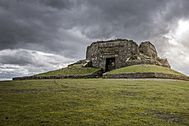Golden Jubilee of George III facts for kids
Quick facts for kids Golden Jubilee of George III |
|
|---|---|
|
Ways the jubilee was remembered. Clockwise: Jubilee Tower on Moel Famau in North Wales; The King's Statue in Weymouth, put up in 1809; The Jubilee Rock in Blisland, decorated in 1810.
|
|
| Genre | Jubilee of British monarch |
| Date(s) | 25 October 1809 |
| Country | |
| Next event | Golden Jubilee of Queen Victoria |
The Golden Jubilee of George III was a big celebration held on 25 October 1809. It marked King George III's 49th year as king, meaning he was entering his 50th year on the British throne. This event was also known as the Grand National Jubilee.
It was the first big celebration of its kind in the United Kingdom and its colonies. However, these celebrations were smaller than those for later British kings and queens.
Contents
Celebrating the King's Jubilee
In March 1809, people started getting ready for the jubilee celebrations. Prices for candles went up because many indoor parties were planned.
Early Celebrations in India
The celebrations actually began early in India on 4 June. This was the King's official birthday. The governor held a special party in Bombay. Important guests from within the Indian Empire and nearby countries attended.
Main Events in the United Kingdom
The main celebrations in the United Kingdom started on 24 October 1809. There was a ball at the Town Hall.
The next day, 25 October, was the big day. King George III and Queen Charlotte had a private church service. This took place at St George's Chapel, Windsor Castle. The King also watched a troop of soldiers. He couldn't join most of the other events because he was not well.
The Royal Horse Guards organized a huge ox roast in Windsor. Queen Charlotte and many royal family members attended. This included the Duke of York, Duke of Kent, Duke of Cumberland, and Duke of Sussex. Princess Elizabeth and Princess Sophia were also there. Later, the Prince of Wales and Princess Charlotte joined them.
A large, fancy arch was built across the road by the Guildhall. The royal family walked through this arch as they entered the town. A "grand fête and firework display" was held at Frogmore. The Queen and several dukes and princesses enjoyed this event.
Public Participation and Special Honours
Shops closed so people could join the festivities. The Lord Mayor of London and the City of London Corporation marched in a procession. They went to St Paul's Cathedral for a special thanksgiving service. Afterward, they had a dinner at the Mansion House.
About 400 merchants and bankers met at the Merchant Taylors' Hall. Many important earls and lords joined them there. To honor the King and Queen, some children born around this time were named Jubilee George or Jubilee Charlotte.
Special Pardons and Memorials
To mark the jubilee, military deserters and prisoners of war were pardoned. This meant they were forgiven for their past actions. People who owed money (debtors) were also set free from prison. However, French prisoners were not pardoned because of the ongoing Napoleonic Wars.
Several landmarks were built to remember the occasion. These included a monument in Windsor, unveiled by the Queen. The King's Statue in Weymouth was also put up. Other memorials were the Jubilee Rock in Blisland and the Jubilee Tower in Moel Famau. Special jugs were made in Liverpool to celebrate. Two types of medals were also created: the King George III Jubilee Medal and the King George III and Queen Charlotte Jubilee Medal.
See also
- Grand Jubilee of 1814
- Golden Jubilee of Queen Victoria
- Golden Jubilee of Elizabeth II




